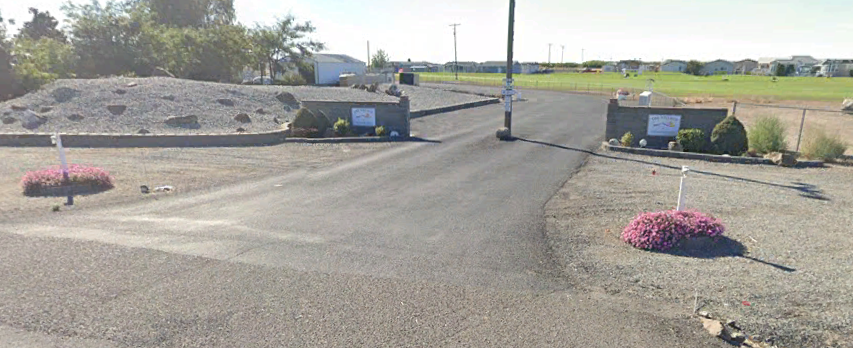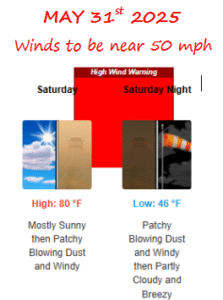Wind speed picked up today at about 10 AM. Gusts have been to 40 mph, enough that the weather folks post a “Red Flag” warning – fast moving fires are a threat. So, it is a warning to not ignite anything. This will go on until early Sunday. Over the next 2 weeks the highest forecast temperature is 90° F. August is unknown at this time.
After the miserable experience with the Ford supplied scissor jack, I cleaned up another I had and put it in a box in the truck bed along with a few various sized wood blocks. Meanwhile, I was awaiting delivery of a floor jack that seems to have been warehoused in a facility in Bloomington, CA., about 50 miles east of LA. The next reports: Troutdale, OR. And Union Gap, WA. It was delivered here at 6:13 PM. I paid $109 with a deal – it is now listed at $144.

The yellow sticker says “team lift” and shows 2 people. Note the plastic straps. FedEx driver lifted it without help and then I put it in the garden cart. Claimed product weight is 66.1 pounds. I’ll make a ramp and add it to the truck.
I ordered a load of “screenings” from a local rock & gravel quarry. As the quarry proceeds to separate larger rocks from smaller and various sizes of gravel there are bits of rock and dirt that don’t fill many needs. The mixture gets its own category: screenings. The quarry is 15 miles away, so while this is an inexpensive material, the delivery charge is a hefty part of the total. I paid $289.38 for 15.49 tons (30,980 pounds; 93.4¢ per pound).

It is the brown material, not the gray pile in the distance. I work in the shade and move around as it does. I’ve spread about 1/3 of it and hope to finish it by Tuesday Noon, when I head to the Costco Store and a meeting with Suzy and Bob.
The least crowded times to shop at Costco are typically on weekdays, especially Tuesday and Thursday afternoons between 3 p.m. and 4 p.m. We’ll meet about 1:45 for lunch and then I’ll get a few things before heading home.
The doe and her fawn will eat leaves of the cherry and apple trees. For about a week I’ve, daily, cut a branch for them. If they are nearby, they will come with me still there. There were a dozen deer in the Alfalfa field across Naneum Road today but we didn’t let them know about the cherry leaf treat. People driving on the road will slow and sometimes stop to view the deer and I can hear and see the action there if I’m out that way.
Keeping Track
on the Naneum Fan
John




 It seems a little late in the year, but I really don’t know. Information on the internet claims birthing begins in late April to early May with peaks during the summer months.
It seems a little late in the year, but I really don’t know. Information on the internet claims birthing begins in late April to early May with peaks during the summer months.
 Many years ago I had a very basic table saw. I loaned it to the man that was taking Brittanys for Nancy when she couldn’t go to a show. I no longer remember why he needed a saw, but it was in a shed that burned. I also do not remember if he offered to replace it. If he talked to me, I don’t remember. It was an inexpensive model and I guess that might have been when I bought the now deceased Craftsman radial arm saw. Anyway, it will be new here next week.
Many years ago I had a very basic table saw. I loaned it to the man that was taking Brittanys for Nancy when she couldn’t go to a show. I no longer remember why he needed a saw, but it was in a shed that burned. I also do not remember if he offered to replace it. If he talked to me, I don’t remember. It was an inexpensive model and I guess that might have been when I bought the now deceased Craftsman radial arm saw. Anyway, it will be new here next week. 
 week. Several phone conversations later, I’m convinced it is not coming back to life. Unfortunately, the service desk person at a local shop said bring it in, so I built a ramp and managed to get it slid into the bed of the pickup. At the store, the head repair guy said “Oh, that’s an electrical tool and we don’t work on that sort of thing.”
week. Several phone conversations later, I’m convinced it is not coming back to life. Unfortunately, the service desk person at a local shop said bring it in, so I built a ramp and managed to get it slid into the bed of the pickup. At the store, the head repair guy said “Oh, that’s an electrical tool and we don’t work on that sort of thing.”
 My April 27th post started with a photo of this tree at the height of blossoming. Lots of flowers need lots of bees but the trees don’t want that much fruit. If I touch a small yellow one it will fall. They will naturally fall and wind helps.
My April 27th post started with a photo of this tree at the height of blossoming. Lots of flowers need lots of bees but the trees don’t want that much fruit. If I touch a small yellow one it will fall. They will naturally fall and wind helps.
 I won’t be cutting trees down this weekend.
I won’t be cutting trees down this weekend.

 The photo on Amazon has tomatoes and an avocado beside the toaster. I’m not sure why. The brand is Mueller. I checked the local BiMart store but didn’t see anything comparable.
The photo on Amazon has tomatoes and an avocado beside the toaster. I’m not sure why. The brand is Mueller. I checked the local BiMart store but didn’t see anything comparable.